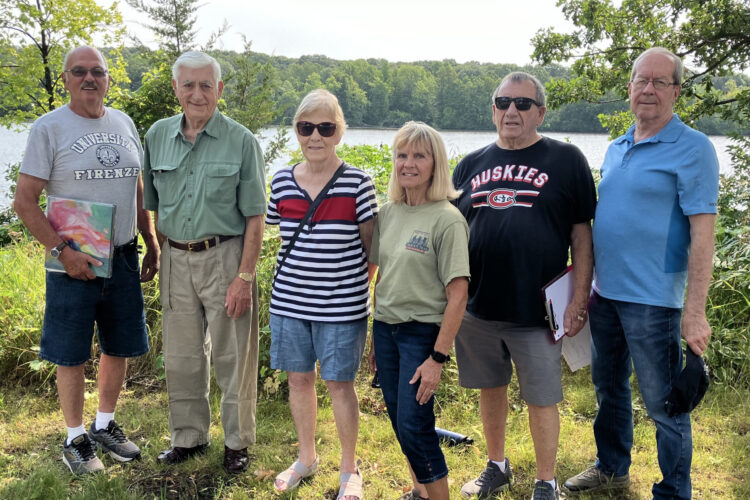by Dennis Dalman
Residents now have the chance to take a walk down Memory Lane, all the way back to 1924 on Riverside Avenue in Sartell.
The series of “Walking History Tours” started in July by the Sartell Historical Society, and each of the tours is led by SHS member Dennis Molitor. The first two tours were held Aug. 14. The next two will take place at 10 a.m. and 6 p.m. Wednesday, Aug. 28. Subsequent tours are scheduled for Wednesdays Sept. 11 and Sept. 25 – at 10 a.m. and 6 p.m. on both of those dates. Each tour takes about an hour. There are now tentative plans to extend the tours for the second and fourth Wednesdays of October (Oct. 9, Oct. 23) also.
Each tour, free of charge, will consist of seven participants 18 years and up. To sign up for a tour, visit the service desk of the Sartell Community Center or call the Center at (320) 258-7331.
Tour leader Molitor will point out landmarks and interesting facts about how history developed on or near Riverside Avenue 100 years ago. Each tour will begin on Riverside at Seventh Street N. just east of Riverside Mall and proceed on Riverside one-half mile south to the “Old Bridge,” now a pedestrian bridge across the Mississippi River.
The following are just some of the historical facts Molitor shares during the tours:
“Third Rapids”
From the mid-1800s to the early years of the 1900s, Sartell’s history had its beginnings along that riverside stretch of land. Many of those developments were initiated by the Massachusetts-born Joseph Birch Sartell, who arrived in this area in 1854 and worked as a millright at a sawmill. At that time, the area that was to become Sartell was known as “The Third Rapids” – so-named by French fur traders.
Flour, Paper
In 1877, Joseph opened a flour mill on the Watab River very near where Watab Creek Park is today. Seven years later, in 1884, Sartell and his seven sons started the Sartell Brothers Lumber Co. Joseph also ran a sawmill on the west side of the river, which opened in 1907 and became the Watab Pulp and Paper Co. and later (in 1946) it developed into the St. Regis Paper Co., then flourished under various owners and names right up to its last incarnation as the Verso Paper Mill. In 2012, an explosion and fire at the mill killed one worker and injured several others, and, ultimately, led to the mill’s permanent closure.
For slightly more than 100 years, that mill had been the economic bedrock of Sartell, providing decent-paying jobs for residents and many out-of-towners, too.
House still there
A white clapboard house that Joseph B. Sartell lived in later in life can still be seen on the walking tour.
Long treks
One astonishing fact Molitor mentions on the walking tours is that slightly more than 100 years ago, when developments began springing up on the east side of “The Third Rapids,” people living on the west side of the river had to walk or ride horses all the way south to Sauk Rapids, then walk up the east side of the river to get to their jobs or for other purposes. That’s because there was no bridge at Sartell – just one at Sauk Rapids. There was, however, another option for crossing the river at that time: a swinging walking bridge of cables and a wood-plank floor that all too many people were hesitant to use. A bridge at Sartell did not open until 1914, which was – decades later – closed for years until it was re-purposed last year as the “Pedestrian Bridge.”
In 1905, work began on a dam across the Mississippi at Sartell, a project that led to the deaths of seven workers. That dam opened in 1907.
Sartell Store
A grocery-and-merchandise store, known as “Sartell Store,” stood for years on the site where the River Boat Depot restaurant/bar is now located.
1925
The DeZurik Valve Co. was founded by Matt DeZurik and opened in 1925 right next to the river on the west side. Along with the paper mill, DeZurik has long been an economic bedrock for the city. It now manufactures industrial valves for large plants, city infrastructures and for the paper-making industry.
Population
Molitor noted it took decades of virtually stagnant population growth until Sartell became the city of about 21,000 it is today.
According to census data, the population was 240 in 1910. Through the 1920s, it grew to 510, in the 1930s to 521 (only 11 more people than the growth in the 1920s), then through the 1940s, it reached 532.
Molitor attributes the slow growth to the two World Wars and to the extreme poverty and lack of opportunities during the Great Depression of the 1930s.
Village
Sartell, named after Joseph B. Sartell, was not incorporated as the “Village of Sartell” until 1907. Finally, it was known as “Sartell” rather than “The Third Rapids.”

Dennis Molitor (left) and his Sartell Walking Tour friends pause for a photo along Riverside Avenue. From left to right are Al Patton, Sandy Hurd, Karell Sartell, Ron Hurd (Sandy’s husband) and Jeff Sartell. All are members of the Sartell Historical Society.



